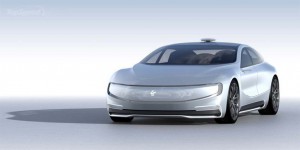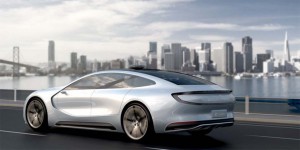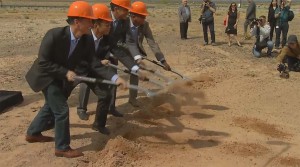
Chinese EV start-up LeEco unveiled its LeSEE concept electric vehicle that will make its debut at the Beijing Auto Show next week.
Chinese battery-car start-up LeEco has given a first look at the new electric concept vehicle it plans to debut at the Beijing Auto Show this coming week. The show car, dubbed the LeSEE offers a strong hint of the production model to follow – but it may also offer a hint of what U.S. EV start-up Faraday Future will bring to market in 2018.
LeEco, which was cofounded by Chinese tech billionaire Jia Yueting, says that the LeSee is not only fully electric but that it also will be highly “connected,” and capable of “automated self-driving.”
“When everyone is questioning us over our ability to develop a car like this and is laughing at us, we are still able to be here and show you this car,” declared Jia, during a preview of the LeSEE in Beijing. “I am so emotional,” he added.
Often called China’s Steve Jobs, a reference to the late cofounder of Apple, Jia is making an aggressive push into the auto industry on both sides of the Pacific. His LeEco aims to take on already established Chinese battery-car companies like BYD. And, in the U.S., he is the major investor in the start-up Faraday Future.
That California-based automaker made an auspicious debut during the Consumer Electronics Show in January and just last week broke ground in North Las Vegas for a $1 billion assembly plant the company intends to put into operation by 2018.
“Our aim is to complete a program that would normally take four years and do it in half the time, while still doing it right,” global manufacturing chief Dag Reckhorn said during the event.
(Faraday Future breaks ground on $1 billion Las Vegas plant. For more, Click Here.)
While Faraday showed off a high-tech battery supercar during the CES debut, it has offered only a teaser image of the production model it hopes will roll out of its Nevada plant. Since the CEO of Faraday also runs LeEco, insiders believe it’s a strong possibility the LeSEE concept could serve as a preview of that model, as well.
Officials at Faraday have promised radical changes not only in the way vehicles are powered, but also in the way they are built and sold, Reckhorn declaring last week that, “We plan to bring the future forward.”
It appears that’s in line with what LeEco aims to do. Founder and CEO Jia went so far as to suggest LeEco might ultimately offer its vehicles for free and make its money on connected car content and services.
(Click Here for details about how rising lithium prices may hinder EV progress.)
“Our cars’ pricing model will be similar to pricing models for cellphones and tv sets we sell today,” he said, adding that, “One day our cars will be free. We are getting there some day.”
While few details were released about the LeEco LeSEE, it is believed to follow a similar design strategy to what Faraday has in store.
In most conventional automobiles, the gas or diesel engine occupies a large space in front of the passenger compartment. But that isn’t necessary in an electric vehicle. As rival Tesla has shown, much of the drivetrain can be mounted in or below the floor of the vehicle. That layout could permit both LeEco and LeSEE to build relatively small vehicles with a surprisingly larger interior.
(To see more about what to expect at this year’s Beijing Auto Show, Click Here.)
By adding autonomous capabilities, meanwhile, LeEco would create an opportunity to sell content to motorists who won’t have to worry about driving duties.


